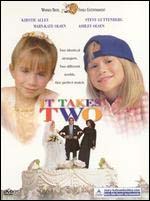It Takes Two
 for some mild language.
for some mild language.
Reviewed by: Brett Willis
CONTRIBUTOR
| Moral Rating: | Better Than Average |
| Moviemaking Quality: |
|
| Primary Audience: | Family |
| Genre: | Comedy / Drama |
| Length: | 1 hr. 41 min. |
| Year of Release: | 1995 |
| USA Release: |

| Featuring |
|---|
| Kirstie Alley, Steve Guttenberg, Mary-Kate Olsen, Ashley Olsen, Jane Sibbett, Philip Bosco |
| Director |
|
Andy Tennant |
| Producer |
| James Orr, Jim Cruickshank, Keith Samples, Mel Efros, Laura Friedman, Andy Cohen |
| Distributor |
When the remake of “The Parent Trap” came out, I wondered why the producers didn’t use the Olsen twins and save on the special-effects budget. Aside from contractural issues, the probable reason is that the Olsens had already done “It Takes Two” (also known as “Me and My Shadow”), which is a cross between “The Parent Trap” and “The Prince and the Pauper”.
Amanda Lemmon (Mary-Kate Olsen) is a tough, streetwise orphan. She and her friends keep getting passed over for adoption, because most couples want only babies. One family is interested in her, but only because they “collect” kids and put them to work in a junkyard. Social worker Diane Barrows (Kirstie Alley) would like to adopt Amanda herself, but can’t because she’s single and doesn’t have a large enough income.
Alyssa Callaway (Ashley Olsen) lives a privileged life with her father Roger (Steve Guttenberg), who is filthy rich. Her mother is deceased, and Roger is planning to marry Clarice Kensington (Jane Sibbett) so Alyssa can have a mother again. He’s blind to the fact that Clarice is a child-hating, gold-digging vixen. Any doubts about her villain status are cleared up at the outset, when we and Alyssa hear her make cruel remarks about Alyssa’s mother.
No, the Olsens’ characters don’t turn out to be long-lost twins. They’re just unrelated lookalikes.
Diane packs off, and accompanies, her orphan brood to a summer camp that was created by Alyssa’s mother. And the Callaways visit their own summer mansion, just across the lake from the camp. Amanda and Alyssa meet, and each wants to find out how the other half lives. If you know movies well, the rest of the story should be clear in outline and uncertain only in detail.
The production values are high, the casting is appropriate, and most everyone turns in a good performance. A few of the young actors playing the orphans underact their parts, exhibiting some degree of camera-shyness. Sibbett deliberately overacts her part, so even the youngest viewers will have no doubt how they’re supposed to react to her.
Content Warnings: Mild language. Amanda and Alyssa have to use drastic measures (make that “dirty tricks”) to get rid of Clarice, but their actions are warranted under the circumstances. The objectionable behavior of the negative characters is clearly portrayed negatively.
The only positive image I object to is the portrayal of “romantic love” (love at first sight) as an ideal. When Alley’s character in “Look Who’s Talking” spouted a line about how you can’t control who you fall in love with, her mother explained that love is a choice. Here, several characters verbalize the idea of getting zapped with “hit one over the fence” type romantic love, and no one is available to correct the notion.
Something in our collective consciousness identifies strongly with films of this type, because they keep getting produced and consumed. We all wish for the perfect family for ourselves, and for the film characters we identify with. None of us actually belongs to a perfect family on Earth. But the Psalmist says:
“When my father and my mother forsake me, then the LORD will take me up” (Psalm 27:10).


PLEASE share your observations and insights to be posted here.
